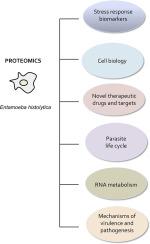Journal of Proteomics ( IF 2.8 ) Pub Date : 2020-07-09 , DOI: 10.1016/j.jprot.2020.103897 Laurence A Marchat 1 , Olga N Hernández-de la Cruz 2 , Esther Ramírez-Moreno 1 , Macrina B Silva-Cázares 3 , César López-Camarillo 2

|
Entamoeba histolytica is the primitive eukaryotic parasite responsible of human amoebiasis, a disease characterized by bloody intestinal diarrhea and invasive extraintestinal illness. The knowledge of the complete genome sequence of virulent E. histolytica and related non-pathogenic species allowed the development of novel genome-wide methodological approaches including protein expression profiling and cellular proteomics in the so called post-genomic era. Proteomics studies have greatly increased our understanding of the cell biology of this ancient parasite. This review summarizes the current works concerning proteomics studies on cell biology, life cycle, virulence and pathogenesis, novel therapies, and protein expression regulation mechanisms in E. histolytica parasite. Also, we discuss the use of proteomics data for the development of novel therapies, the identification of potential disease biomarkers and differential diagnosis between species.
Significance
Entamoeba histolytica is the unicellular protozoan parasite responsible of human amoebiasis, a serious disease with worldwide distribution characterized by bloody intestinal diarrhea and invasive extraintestinal illness including peritonitis and liver, pulmonary and brain abscesses. The post-genomic era allowed the development of proteomic studies including protein expression profiling and cellular proteomics.
These proteomics studies have greatly increased our understanding on cell biology, life cycle (cyst-trophozoite conversion), virulence, pathogenesis, novel therapies, and protein expression regulation mechanisms in E. histolytica. Importantly, proteomics has revealed the identity of proteins related to novel therapies, and the identification of potential disease biomarkers and proteins with use in diagnosis between species. Hopefully in the coming years, and through the use of more sophisticated omics tools, including deep proteomics, a more complete set of proteins involved in the aforementioned cellular processes can be obtained to understand the biology of this ancient eukaryote.
中文翻译:

蛋白质组学方法可了解解胞变形虫变形虫原虫的细胞生物学和毒力。
溶血性变形杆菌是引起人类阿米巴病的原始真核寄生虫,这种疾病的特征是血性腹泻和侵袭性肠外疾病。对有毒的溶组织性大肠杆菌和相关非致病性物种的完整基因组序列的了解,使得在所谓的后基因组时代,新的全基因组方法学方法得以发展,包括蛋白质表达谱分析和细胞蛋白质组学。蛋白质组学研究极大地增进了我们对这种古老寄生虫的细胞生物学的了解。这篇综述总结了有关蛋白质组学研究的最新工作,这些蛋白质组学研究了溶血性大肠杆菌的细胞生物学,生命周期,毒力和发病机理,新疗法以及蛋白质表达调控机制。寄生虫。此外,我们讨论了蛋白质组学数据在开发新疗法,鉴定潜在疾病生物标志物和种间鉴别诊断中的应用。
意义
溶血性变形杆菌是引起人阿米巴病的单细胞原生动物寄生虫,阿米巴病是一种全球性分布的严重疾病,其特征是血性腹泻和侵袭性肠外疾病,包括腹膜炎和肝,肺和脑脓肿。后基因组时代允许蛋白质组学研究的发展,包括蛋白质表达谱分析和细胞蛋白质组学。
这些蛋白质组学研究极大地增进了我们对溶组织性大肠杆菌的细胞生物学,生命周期(囊藻-滋养体转化),毒力,发病机理,新疗法和蛋白质表达调控机制的了解。重要的是,蛋白质组学已经揭示了与新疗法有关的蛋白质的身份,并鉴定了潜在的疾病生物标志物和蛋白质,以用于物种之间的诊断。希望在未来的几年中,通过使用包括深层蛋白质组学在内的更复杂的组学工具,可以获得涉及上述细胞过程的更完整的蛋白质,以了解这种古老的真核生物的生物学特性。











































 京公网安备 11010802027423号
京公网安备 11010802027423号